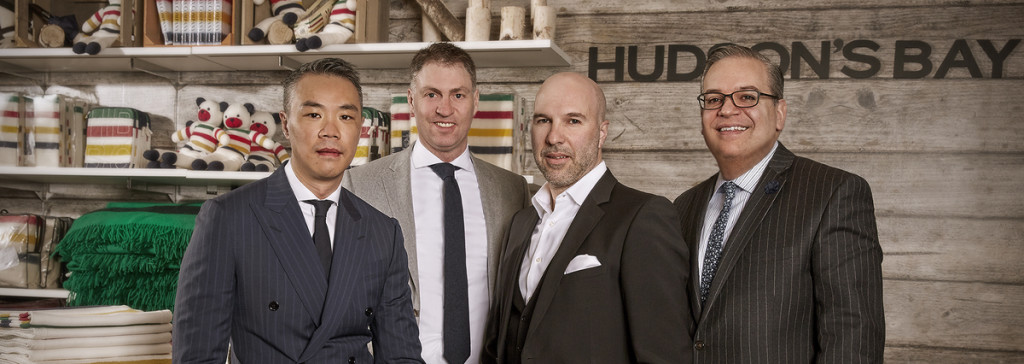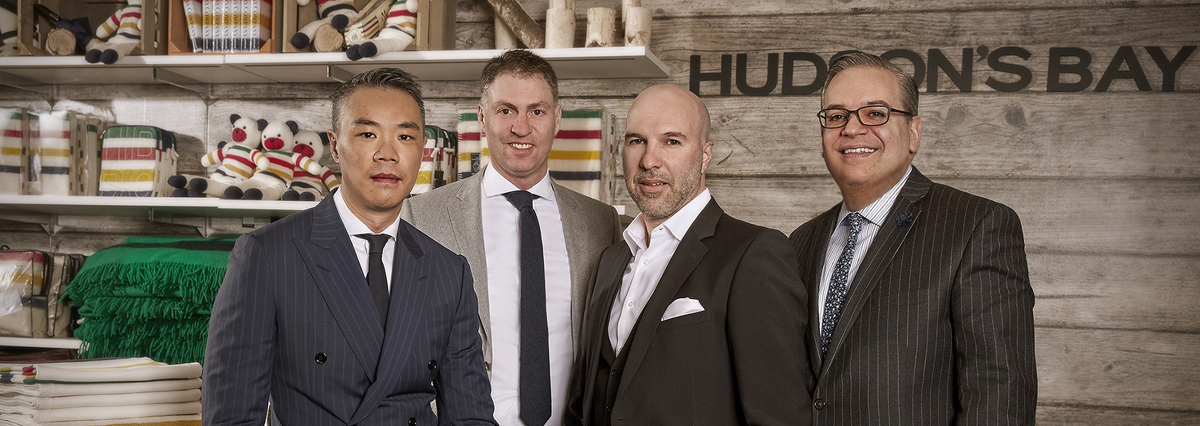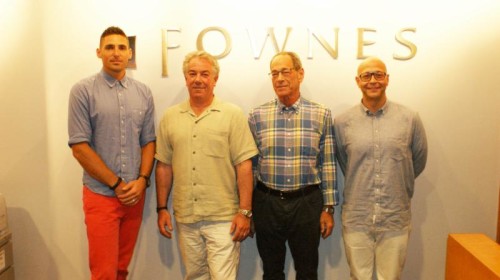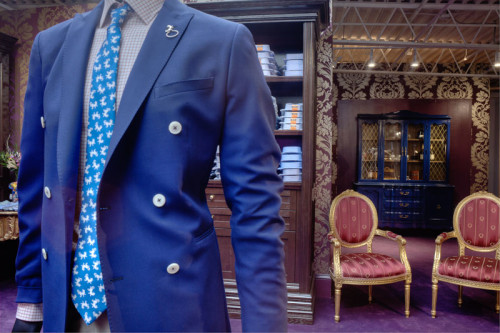The Hudson’s Bay/Lord & Taylor Menswear Team Takes Fashion Forward


The menswear team at Hudson’s Bay and Lord & Taylor is on a mission to take these heritage stores into the future. Here, we talk to the execs who are making it all happen: Wayne Drummond, group SVP/GMM ladies’ sportswear, men’s, kids’ and luggage, Hudson’s Bay and Lord & Taylor; Tom Eckrich, DMM Lord & Taylor; Jim Monteiro, DMM Hudson’s Bay; and Nelson Mui, men’s fashion director, Hudson’s Bay and Lord & Taylor.
What’s the current mission for Hudson’s Bay and Lord & Taylor?
Wayne Drummond: Our mission is simple: to create an exciting and inclusive shopping experience for men. We want our guy to feel that our stores are his stores. Many have been undergoing renovations; the most recent is our Queen Street store. We want to create a loft-like environment so guys feel comfortable, hang out and shop. We spent a lot of time on our target customer and we define him by his lifestyle rather than his age. We offered three style lanes in our men’s world: classic, contemporary and we bring it all together with denim. Our approach is the same at Hudson’s Bay and Lord & Taylor, but our competitive advantage in Canada is the ability to trade in every price zone.
What are the core price zones?
Jim Monteiro: If you break down our lifestyles by classic/updated/contemporary, and our pricing profile by good/better/best, then the bullseye would be better/updated. With styles moving to the right (classic is getting a little more updated, updated a little more contemporary and contemporary a little more modern) then we’re pushing better/updated. That’s what’s keeping us current.
What else is working?
Monteiro: At Hudson’s Bay, we continue to do exceptionally well with denim. I keep thinking that denim will hit this wall but it’s hasn’t. It’s been a huge success for us and continues to grow year after year. We’re introducing active as a new element to round out the assortment, but we still think our big opportunity is to touch on contemporary from a better/best perspective. The important thing for us is the cool factor. There are lots of options in classic whether you’re a good or a better customer. If we keep focusing in on those areas, we’ll continue to win because we have a very strong base in the classic and updated.
Tom Eckrich: Denim has been a huge growth area for Lord & Taylor, particularly on the premium end with brands like 7 For All Mankind, Hudson, Joe’s Jeans, G-Star, Diesel and True Religion, and we just added AG. Denim retailing for just under the $200 threshold is where we get the biggest bang for our buck. Slim/straight styles are our best-selling silhouettes and washes are trending towards dark, but we have a wide variety. We’ve devoted so much more space to this business with our Fifth Avenue renovation (it used to be a few thousand square feet and now it’s about 10,000 square feet), and it’s been a huge win. So from a sportswear perspective, we’ve effected the most change with denim and everything that surrounds it for a much more contemporary feel.
Nelson Mui: A lot of our premium denim brands feature a large offering of non-denim five-pocket colored trousers and that’s been really strong. Younger men are more adventurous in their style choices, and one thing that’s been creeping into contemporary is this influence of streetwear. We already had a huge matrix of core streetwear brands at Hudson’s Bay (Obey, Stussy and Billionaire Boys Club), and at Lord & Taylor, we’re picking up brands like Eleven Paris. We’re finding it to be a complement to the denim brands that we’ve been growing. At Hudson’s Bay, we carry brands like Opening Ceremony, which has elements of this street influence—whether it’s a longer T-shirt or bold graphics and sport numbering—it’s sort of crept into all aspects of contemporary. It’s even stronger at the designer level, so it will continue in contemporary.
The buzz today is all about altheisure. How are you representing it at Hudson’s Bay and Lord & Taylor?
Mui: It’s definitely trending: you’re seeing a more sophisticated take on it at the premium level. I cover the collections in London, Florence, Milan and Paris and then we go as a team to Vegas. It’s being shown on runways and in presentations. It’s something that’s registered, and there’s definitely a valid customer for it, but it remains to be seen whether it can become a mass thing at the premium level.
What does the growth in contemporary mean for tailored clothing?
Monteiro: Suit separates have grown dramatically at Hudson’s Bay simply because we’ve been offering slimmer models. Now we’re probably 70 percent slim vs. 5 to 10 percent four or five years ago. So slim is not new anymore, it’s just the norm and that’s why suit separates have taken off the way they have. And the sportcoat is not a traditional sportcoat anymore; it’s shorter, more fitted and less constructed. It’s starting to gain some traction in Canada and it hasn’t even gone as far as everyone has been hoping. We’re selling everything that goes with the jacket, from denim to the new slim-fit twills, and if you’re more adventurous there’s the jogger pant. The hipster guys know how to pull it together with the right shoes. When we first saw Zanerobe’s jogger 18 months ago, it felt years away, but we’ve been selling it for a few seasons now and it’s tracking nicely.
So that’s the changing dynamic, and as Nelson mentioned earlier, there’s a lot more creativity going on with men who understand fashion and can pull it together. When slim first started happening, a lot of guys didn’t think it was for them. But then they tried it on and realized it wasn’t skinny, it was actually a better fit. So there’s a comfort level that will come when guys want to know what bottoms to wear with a sportcoat.
Eckrich: We’ve been on a long winning streak in tailored clothing and there have been lots of reasons why. Specifically, we’ve done quite well differentiating our sales with brands like Black Brown and Tallia. We’re also moving towards more suit separates; it’s just the writing on the wall. From a fashion standpoint we’re creating items that are exclusive to us in order to differentiate. And we’re using tailored as a home base to pull in more lifestyle categories. The guy today wants to wear a jacket, a cotton pant and a shirt with no tie, so we’re pulling that together to give him options in the tailored clothing department. We’re showing customers that you can add color to your wardrobe in more ways than just a tie.
For example, linen will be very important to us across many brands this spring. It’s a business that Lord & Taylor had for a long time, but now it’s trend-right, so it’s becoming very big. Formalwear has also done well for us: it’s still a small part but the trends are amazing, so we’re pulling together all the elements to create that look. We have several blue tuxedos featured in our spring style guide. And we’ve gotten a lot of traction from our prom mailer.
Mui: I would add that seasonal suiting (seasonal colors and weights) has also been strong.
Drummond: Seasonal clothing is working because guys are invested in themselves; they’re making some bolder styling moves. The other two categories that have been explosive are accessories and footwear. Take Tom for example: today he’s wearing a lapel flower. So whether it’s pins, pocket squares, bracelets or colored socks, our customer is confident accessorizing. As for footwear, Jim likes to say that men used to have a pair of black shoes, a pair of brown shoes and one pair of sneakers; now they own the closet in terms of shoes. Footwear is an expression of his style and his look, so that’s been a category we’re having a lot of fun with.
Eckrich: We’re also having success with bags. There are lots of different shapes (the backpack is huge) and occasions to use them: he’s bringing it to work, he’s using one on the weekend. Bags are really up and coming and we think it’s just the beginning.
Monteiro: Even outerwear. My dad, probably like many dads, had one coat that he’d wear all winter. Now guys are wearing a different coat for each change in temperature. So that’s the fun part: there are lots of coats in men’s closets these days.
With so much excitement, which categories are disappointing?
Drummond: Where we’re having the most challenge is with brands, predominately classic, where there’s a lack of newness and change. As Jim said, everything is moving to the right. If you’re too traditional today then you’re off the radar tomorrow. It’s moving very quickly. So we’re challenging the brands that are not moving fast enough to meet the needs of our current customer, who is getting more confident to style himself, or the very quickly emerging Millennial, who has a specific taste. We have some of those benchmark brands that are not moving fast enough, and we’re challenging them.
Monteiro: Those classic brands are very important to us, but we’re basically managing them versus the updated contemporary brands that we’re building. And there’s a difference.
As fashion moves to the right, is price moving with it?
Drummond: Not necessarily. The Millennial isn’t solely consumed with premium; they’re consumed with a specific style choice. Our nine-box matrix specifies where we want brands to fall within price and style parameters. We’re continuously evaluating to determine where we have opportunities, where we overlap, where we need to slow something down or begin to pull back. We all know where the filters are and we use that as our guide to make decisions.
Monteiro: It’s evident by the growth of stores like H&M and Topman that affordability is a factor. We have Topman exclusively in Canada so we can offer that price level. Of course if they want to spend more money, we have product in that zone too.
Mui: There’s a more disposable concept with the Millennial generation: they want this now and it’s going to be obsolete soon anyway. Men’s fashion is getting much faster and moving closer to the speed of women’s. That’s why we’re seeing this explosion in menswear right now.
Does faster turn mean higher markdowns?
Monteiro: It can, but the reality is that we know we have a business to run, so we know which programs to focus on. We have an internal mix that we work with that ensures we have healthy margins.
Can you discuss your promotional strategy?
Monteiro: Our promotional strategy was much different when we were “the Bay” vs. Hudson’s Bay today. We’re now much more strategic with our big events like Christmas and Father’s Day. We go after those key events in terms of specific product we want to offer. We also believe, because we have new styles coming in every month, that we should go through that 8, 12 week cycle of in and out through our regular markdown cadence, which keeps us relevant. We’re using markdowns in-season as a strategy rather than end-season clearance. We’re not using Off 5th, but that doesn’t mean we won’t: that’s still to be discussed.
Eckrich: We’re not really using Off 5th either but that’s probably going to change soon.
We’ve been hearing that the growth in menswear is outpacing the growth in womenswear. Are you finding that to be true?
Eckrich: The pace of change is remarkable. It used to be that there wasn’t that much new happening in men’s—maybe there was color change—but now there’s an enormous amount of change every season. Younger people are used to seeing that change and wearing different kinds of things. It’s not as uniform-ish as it used to be.
Monteiro: The Millennial consumer, which is now the largest demographic, is putting a lot of thought into what he wears. He’s on his phone constantly, he’s reading blogs and sees how celebrities dress. And as Wayne mentioned, we have a core customer that we’re going after, and it’s not necessarily an age, but more of a youthful mentality.
Mui: There’s a certain amount of fashion literacy with the younger generation. You can’t go backwards, you can’t unlearn. They’re getting all of these ideas from their peers and from the media. There’s so much more men’s fashion content and fashion news out there that people suddenly want to try, and the younger generation embraces it. The media is where they’re getting all their information first, and then they shop. It’s not like they wander a department store to browse; they go with purpose. They know in advance they want this kind of jogger or that kind of high-top. They get all the information first and then shop for it.
Monteiro: Nelson will ask, “How do I know I’m doing a good job forecasting fashion?” and I say, “When I’m feeling uncomfortable with what you’re offering, then you know you’re doing a good job.” Tom was talking about the newness and freshness that we need, and my fear has always been getting too predictable. If we’re predictable, we’ve failed. When you renovate a store it’s easy to look new, but how do we keep that excitement every season? So every season, especially for fall, we have to offer something new, fresh and innovative.
How do you test emerging brands?
Monteiro: We’ll try it in our top doors. In Canada, Queen Street and Vancouver will be the first two that we try. And if we’re going to test something, we make sure that we test it big and feature it prominently.
With so much crossover in both stores, why have separate buying teams?
Drummond: While there’s a lot similarity between our customers, we have very distinct DNA. Both Hudson’s Bay and Lord & Taylor are deeply rooted in their own heritage. With Lord & Taylor, I like to say that we’re set up to behave like a specialty store inside the body of a department store, whereas Hudson’s Bay is Canada’s largest department store. We have the bandwidth and the responsibility to offer moderate to luxury. So there are very distinct differences that we would not want to compromise or dilute. We have enough cross leverage: our management during the first two years of our integration built a lot of bridges and transferred a lot of intelligence across our two organizations. We found out that we were under-penetrated on certain things at Hudson’s Bay whereas we had strong penetration at Lord & Taylor, and vice versa. So we’ve been able to leverage that and now it’s about taking all the intelligence we gleaned in the early stages of that integration and driving it into each of our banner propositions. That’s why we keep the two banners separate.
How is Lord & Taylor menswear different from Macy’s menswear?
Eckrich: It’s vastly different. We strive to look for brands, categories and items that we can push to a much larger penetration of our total business. If you look at Macy’s, a brand might be in 15 to 20 doors which is nothing to their total; we might be in 15 to 20 doors and that’s almost half of our doors. While it’s difficult in the U.S. to secure exclusive brands, we’re working with brands on creating exclusive product. We think it’s a big differentiator and we’re having much success where we can pull that together.








